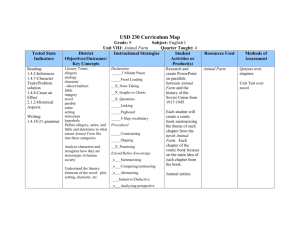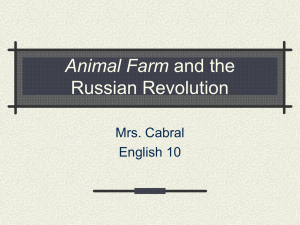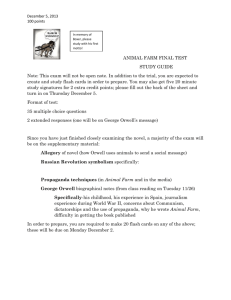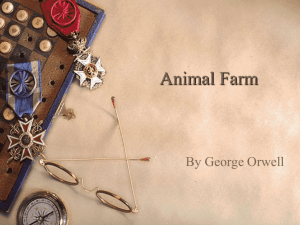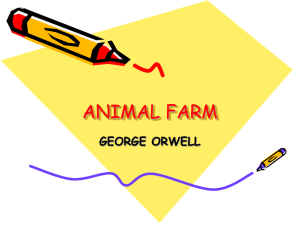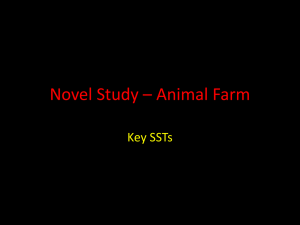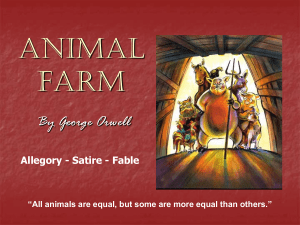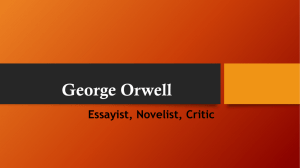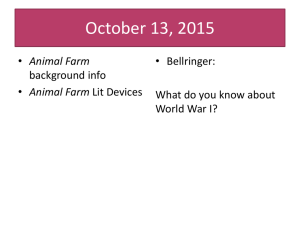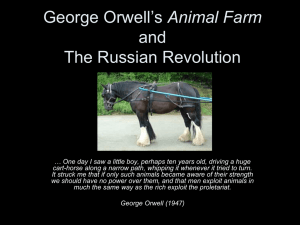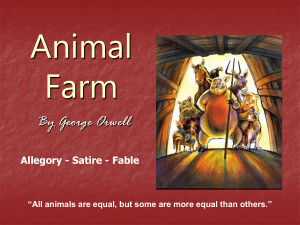Animal_Farm
advertisement
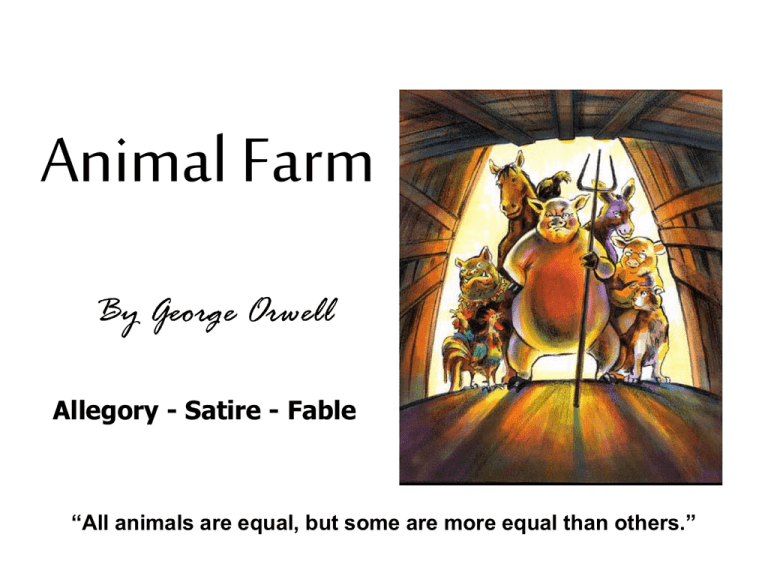
Animal Farm By George Orwell Allegory - Satire - Fable “All animals are equal, but some are more equal than others.” George Orwell British Author & Journalist • 1903-1950 • Born in India – The family was not very wealthy; they were dependent on the British Empire for their livelihood and prospects. • Noted as a novelist and critic, as well as a political and cultural commentator. • He was skeptical of governments and their willingness to forsake ideas in favor of power. • Believed that new leaders are eventually corrupted by power. “ABSOLUTE POWER CORRUPTS ABSOLUTELY” What is Animal Farm? • A masterpiece of political satire, Animal Farm is a fable or tale about oppressed individuals who long for freedom but ultimately are corrupted by assuming the very power that had originally oppressed them. • The story traces the deplorable conditions of mistreated animals who can speak and who exhibit many human characteristics. After extreme negligence by their owner, the animals revolt and expel Mr. Jones and his wife from the farm. Significance Today • But why – now that Soviet Communism has fallen and the Cold War is over – does Animal Farm deserve our attention? • The answer lies in the power of allegory. Allegorical fables, because they make comparisons and connections that are meaningful to any reader in any historical period. • The story of Animal Farm will always have lessons to teach us about the ways that people abuse power and manipulate others. Allegory – Animal Farm has two levels of meaning. On the surface, it is a fable about animals. But on a second level, the animals stand for types of people or ideas. The way the animals interact and the way the plot unfolds says something about the nature of people or the value of ideas. Any type of fiction that has multiple levels of meaning in this way is called an allegory. Satire • In a satire, the writer attacks a serious issue by presenting it in a ridiculous light or otherwise poking fun at it. Orwell uses satire to expose what he saw as the myth of Soviet socialism. Thus, the novel tells a story that people of all ages can understand, but it also tells us a second story— that of the real-life revolution. Soviet Coat of Arms When History and Literature Merge • Critics often consider Animal Farm to be an allegory of the Russian Revolution. In the early 1900s, Russia’s Czar Nicholas II faced a suffering nation. • Many Russian peasants were struggling to survive under an oppressive government. • By 1917, a revolution began, the Czar’s government was overthrown and replaced by the Bolshevik leadership of Vladimir Lenin. • When Lenin died in 1924, his former colleagues Leon Trotsky, hero of the early Revolution, and Joseph Stalin, head of the Communist Party, struggled for power. Stalin won the battle, and he deported Trotsky into permanent exile. Czar Nicholas II Vladimir Lenin Leon Trotsky Joseph Stalin Napoleon = Joseph Stalin • Once in power, Stalin began to move the Soviet Union into the modern industrial age. His government seized land in order to create collective farms. Many peasants refused to give up their land, so to counter resistance Stalin used vicious military tactics. Rigged trials led to executions of an estimated 20 million government officials and ordinary citizens. The government controlled the flow and content of information to the people, and all but outlawed churches. • He loved power and used the KGB (secret police) to enforce his ruthless, corrupt antics. Joseph Stalin Snowball = Leon Trotsky • Snowball – Boar who becomes one of the rebellion’s most valuable leaders. – After drawing complicated plans for the construction of a windmill, he is chased off of the farm forever by Napoleon’s dogs and thereafter used as a scapegoat for the animals’ troubles. • Leon Trotsky – A pure communist leader who was influenced by the teachings of Karl Marx. – He wanted to improve life for people in Russia, but was driven away by Lenin’s KGB. California Standards • 3.3 Analyze interactions between main and subordinate characters (conflicts, motivations, and influences). • 3.4 Determine character traits through narration and dialogue. • 3.7 Understand the author’s use of allegory, satire, and irony to emphasize particular points. • 3.12 Analyze the way in which a work of literature is related to the issues and themes of the time period. • 2.2a Write a comprehensive essay that shows the students grasp of Orwell’s significant points. • 2.2b Support viewpoints with accurate references to the text.
